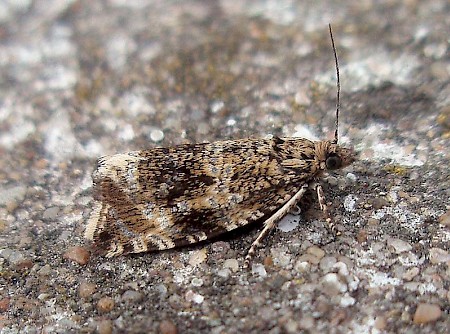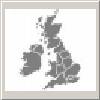49.166 BF1076
Celypha lacunana
([Denis & Schiffermüller], 1775)
Wingspan 16-18 mm.
A very common species throughout Britain, it can often be disturbed during the day from vegetation along woodland fringes, verges, grassy fields and hedges.
Later in the evening is the moth's normal flying time, when it can be attracted to light.
It has quite a long flight period, from May to August.
The larvae feed on a wide variety of herbaceous plants.
A species with many more larval varieties than illustrated. Please refer to more details below.
- Larva (description Ian F. Smith):
Foodplants: August to June, overwinters off plant, in spun leaves, shoots and flowers of a wide range of herbaceous plants, ferns, shrubs and trees; Daucus, Succisa, Ononis, Mentha, Caltha, Ranunculus, Inula, Cirsium, Chrysanthemum, Lysimachia, Chenopodium, Urtica, Artemisia, Filipendula, Fragaria, Sanguisorba, Epilobium, Rubus, Salix, Betula, Ligustrum, Larix, Picea, Pteridium etc.
Length: 15 mm April described. 11mm specimen found 14thAug., pupated 25th Aug., emerged 30th Aug.1999; either delayed developer, or a second generation.
Head: Shiny black (various shades of brown marked black laterally) with yellowish white clypeus and brown labrum.
Prothorax (T1): Prothoracic shield black (various shades of brown) divided by a very fine medial line coloured as integument, anterior border as integument or a light greyish brown. Blackish prespiracular and subventral pinacula.
Mesothorax (T2): One pair widely spaced bisetose dorsal pinacula; one unisetose lateral pinaculum; two pinacula level with spiracles, the anterior bisetose; one subventral pinaculum.
Metathorax (T3): As T2
Thoracic legs: Black or pitchy brown. (yellowish, cream, brown).
Body: Various shades of brown. (light yellow, cream, green, greyish white).
Spiracles: Small, unobtrusive. Peritreme black or dark brown.
Abdominal pinacula: Shiny, coloured as integument or a little darker. (shiny black).
Setae: Translucent. Distally colourless, basally tinted light brown.
Anal segment: Anal plate shiny black or pitchy brown (light yellowish cream, yellow marked brown) with a posterior lobe . Dark anal comb.
Prolegs: Coloured as integument. Crochets dark brown. Anal prolegs with large dark brown pinaculum postero-laterally and two dark brown pinacula anteriorally.
Comment: The multiplicity of larval varieties makes confusion possible with many species. Rearing to imago is advised for confirmation. The posterior lobe on the anal plate may be constant.

 UKMoths
UKMoths 








